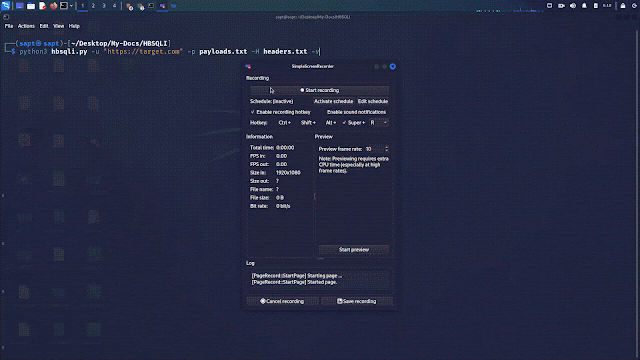HBSQLI – Automated Tool For Testing Header Based Blind SQL Injection
HBSQLI is an automated command-line tool for performing Header Based Blind SQL injection attacks on web applications. It automates the process of detecting Header Based Blind SQL injection vulnerabilities, making it easier for security researchers , penetration testers & bug bounty hunters to test the security of web applications.
Disclaimer:
This tool is intended for authorized penetration testing and security assessment purposes only. Any unauthorized or malicious use of this tool is strictly prohibited and may result in legal action.
The authors and contributors of this tool do not take any responsibility for any damage, legal issues, or other consequences caused by the misuse of this tool. The use of this tool is solely at the user’s own risk.
Users are responsible for complying with all applicable laws and regulations regarding the use of this tool, including but not limited to, obtaining all necessary permissions and consents before conducting any testing or assessment.
By using this tool, users acknowledge and accept these terms and conditions and agree to use this tool in accordance with all applicable laws and regulations.
Installation
Install HBSQLI with following steps:
$ git clone https://github.com/SAPT01/HBSQLI.git
$ cd HBSQLI
$ pip3 install -r requirements.txt Usage/Examples
usage: hbsqli.py [-h] [-l LIST] [-u URL] -p PAYLOADS -H HEADERS [-v]
options:
-h, --help show this help message and exit
-l LIST, --list LIST To provide list of urls as an input
-u URL, --url URL To provide single url as an input
-p PAYLOADS, --payloads PAYLOADS
To provide payload file having Blind SQL Payloads with delay of 30 sec
-H HEADERS, --headers HEADERS
To provide header file having HTTP Headers which are to be injected
-v, --verbose Run on verbose modeFor Single URL:
$ python3 hbsqli.py -u "https://target.com" -p payloads.txt -H headers.txt -vFor List of URLs:
$ python3 hbsqli.py -l urls.txt -p payloads.txt -H headers.txt -vModes
There are basically two modes in this, verbose which will show you all the process which is happening and show your the status of each test done and non-verbose, which will just print the vulnerable ones on the screen. To initiate the verbose mode just add -v in your command
Notes
-
You can use the provided payload file or use a custom payload file, just remember that delay in each payload in the payload file should be set to 30 seconds.
-
You can use the provided headers file or even some more custom header in that file itself according to your need.
Demo
A considerable amount of time and effort goes into maintaining this website, creating backend automation and creating new features and content for you to make actionable intelligence decisions. Everyone that supports the site helps enable new functionality.
If you like the site, please support us on “Patreon” or “Buy Me A Coffee” using the buttons below
To keep up to date follow us on the below channels.



![[SAFEPAY] - Ransomware Victim: www[.]iecsolutions[.]com 3 image](https://www.redpacketsecurity.com/wp-content/uploads/2024/09/image-300x300.png)
![Cobalt Strike Beacon Detected - 43[.]245[.]198[.]185:80 4 Cobalt-Strike](https://www.redpacketsecurity.com/wp-content/uploads/2021/11/Cobalt-Strike-300x201.jpg)